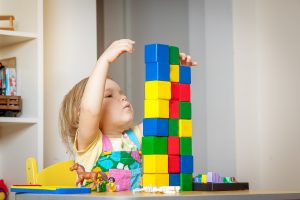Selecting a toy that you know will elicit giggles and put a huge smile on your child’s face is super fun. However, the American Academy of Pediatrics (AAP) strongly advises parents to evaluate the safety of a toy before buying it. Here are no-nonsense and easy-to-follow tips when purchasing toys to ensure your little one’s safety.
Basic Toy Safety Tips
- Don’t buy toys with sharp edges and points.
- Buy toys that are appropriate for your kid’s age. If the label says “for kids 6+”, then don’t buy it for your 3-year-old child.
- Look for toys that can be cleaned easily or washable and make sure that the label clearly states non-toxic because you know that the toy will eventually end up chewed up by your little one.
- Make sure that your younger kids can’t reach the toys of your older kids.
- Refrain from buying toys with cords, ribbons, loose strings and anything that can get tangled around the neck of your child.
- Lower your child’s risk of choking by avoiding games or toys that have parts smaller than 1.75”. In general, any object or toy part that you can fit inside an empty roll of toilet paper is considered a choking hazard so avoid them at all costs. Also, avoid toys stuffed with pellets or beans.
- Avoid toys that shoot something, like guns, darts, or a bow and arrow. These can cause injuries, particularly to the eyes.
- Beware of huge storage containers and chests for storing toys since your child can easily climb inside, get trapped inside and suffocate. They can also pinch your child’s tiny fingers.
- Only purchase UL-approved electric toys and don’t ever allow your kid to use toys with frayed cords since these could lead to electric burns and shocks.
- If you still have a child who uses a crib, refrain from hanging toys with ropes, wires, cords, ribbons, etc. that could get tangled around your kid’s limbs or worse, the neck. Always remember to remove the toys from the crib when your baby is sleeping there.
A Crucial Note on Toys and Gender-Based Stereotypes
 According to the AAP, every child should have the chance to explore the different gender roles and play styles. So give your children toys, puzzles and books that show women and men in diverse and non-stereotypical gender roles, such as working mothers, stay-at-home fathers, policewomen and male nurses, among others.
According to the AAP, every child should have the chance to explore the different gender roles and play styles. So give your children toys, puzzles and books that show women and men in diverse and non-stereotypical gender roles, such as working mothers, stay-at-home fathers, policewomen and male nurses, among others.
Common Sense Guidelines for Toy Safety
If there’s one thing that pediatric specialists in Salem can agree on when it comes to toy safety is that all parents should take the necessary time to read, understand and follow labels.
Make sure that your younger kids know how to play with a toy before letting them play with it on their own. Also, make sure to buy toys that won’t easily break. Toys are childhood treasures, but if you fail to practice caution, they can be hazardous. So, keep these tips in mind when buying toys for your precious little ones.

